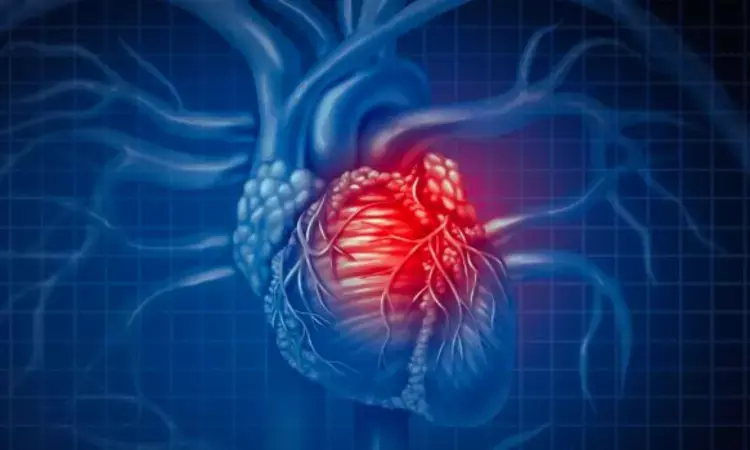- Home
- Medical news & Guidelines
- Anesthesiology
- Cardiology and CTVS
- Critical Care
- Dentistry
- Dermatology
- Diabetes and Endocrinology
- ENT
- Gastroenterology
- Medicine
- Nephrology
- Neurology
- Obstretics-Gynaecology
- Oncology
- Ophthalmology
- Orthopaedics
- Pediatrics-Neonatology
- Psychiatry
- Pulmonology
- Radiology
- Surgery
- Urology
- Laboratory Medicine
- Diet
- Nursing
- Paramedical
- Physiotherapy
- Health news
- Fact Check
- Bone Health Fact Check
- Brain Health Fact Check
- Cancer Related Fact Check
- Child Care Fact Check
- Dental and oral health fact check
- Diabetes and metabolic health fact check
- Diet and Nutrition Fact Check
- Eye and ENT Care Fact Check
- Fitness fact check
- Gut health fact check
- Heart health fact check
- Kidney health fact check
- Medical education fact check
- Men's health fact check
- Respiratory fact check
- Skin and hair care fact check
- Vaccine and Immunization fact check
- Women's health fact check
- AYUSH
- State News
- Andaman and Nicobar Islands
- Andhra Pradesh
- Arunachal Pradesh
- Assam
- Bihar
- Chandigarh
- Chattisgarh
- Dadra and Nagar Haveli
- Daman and Diu
- Delhi
- Goa
- Gujarat
- Haryana
- Himachal Pradesh
- Jammu & Kashmir
- Jharkhand
- Karnataka
- Kerala
- Ladakh
- Lakshadweep
- Madhya Pradesh
- Maharashtra
- Manipur
- Meghalaya
- Mizoram
- Nagaland
- Odisha
- Puducherry
- Punjab
- Rajasthan
- Sikkim
- Tamil Nadu
- Telangana
- Tripura
- Uttar Pradesh
- Uttrakhand
- West Bengal
- Medical Education
- Industry
Patients with thicker epicardial adipose tissue and HFpEF at higher risk of coronary artery disease: Study

China: A recent study has revealed that epicardial adipose tissue (EAT) is correlated with coronary artery disease (CAD) in patients with heart failure with preserved ejection fraction (HFpEF). The findings were published online in the International Journal of Cardiology Cardiovascular Risk and Prevention on February 1, 2024.
"This retrospective study revealed that patients with thicker epicardial adipose tissue and HFpEF were more likely to present with coronary artery disease, independent of their BMI and other known risk factors of CAD including age, hypertension, smoking, and type 2 diabetes," the researchers reported.
Heart failure with preserved ejection fraction presents as a clinically heterogeneous syndrome, and developing therapies for this condition has been limited in success. The presence of coronary artery disease is a common complication in HFpEF, with the incidence ranging from 47 % to 68 % in different cohorts.
The epicardial adipose tissue lies between the pericardium's visceral layer and the myocardial surface and is suggested to play a role in the development of atherosclerosis and CAD. Previous studies have shown that EAT is closely associated with the pathophysiological processes of HFpEF. However, whether EAT raises the risk of CAD in HFpEF patients remains unknown.
To determine if EAT increases the risk of CAD in patients with HFpEF, Fengling Peng, The First Affiliated Hospital of Chongqing Medical University, Chongqing, China, and colleagues conducted a retrospective cohort study of 112 HFpEF patients hospitalized in the First Affiliated Hospital of Chongqing Medical University from 2021 to 2022, who underwent at least one coronary artery examination.
EAT thickness was measured by echocardiography. Multifactorial binary logistic regression was used to analyze the correlation between EAT and coronary artery disease.
The study led to the following findings:
- Compared to patients without CAD, EAT thickness was noticeably higher in patients with CAD.
- Spearman correlation analysis showed that CAD and Gensini scores (r = 0.334) positively correlated with EAT thickness.
- After adjusting for age, body mass index, gender, hypertension, smoking history, type 2 diabetes mellitus, and a part of biochemical indexes, EAT thickness was associated with CAD (OR ranged from 1.450 to 1.472).
The study limitations were: firstly, study analysis did not occur in a diverse and heterogeneous cohort including a multi-ethnic population and only in homogenous Asians; secondly, echocardiographic measurement was safe, noninvasive, and economical, but quantification of EAT is difficult; thirdly, the retrospective nature of the study; and lastly the selection bias.
"A grand-scale investigation is needed to reveal the association between EAT and CAD in HFpEF patients," the research team concluded.
Reference:
Zhao, J., Xie, J., Liu, Z., Duan, Q., Gao, L., Peng, F., & Sun, M. (2024). Epicardial adipose tissue: A marker of coronary artery disease in patients with heart failure with preserved ejection fraction. International Journal of Cardiology Cardiovascular Risk and Prevention, 200243. https://doi.org/10.1016/j.ijcrp.2024.200243
Dr Kamal Kant Kohli-MBBS, DTCD- a chest specialist with more than 30 years of practice and a flair for writing clinical articles, Dr Kamal Kant Kohli joined Medical Dialogues as a Chief Editor of Medical News. Besides writing articles, as an editor, he proofreads and verifies all the medical content published on Medical Dialogues including those coming from journals, studies,medical conferences,guidelines etc. Email: drkohli@medicaldialogues.in. Contact no. 011-43720751


